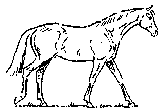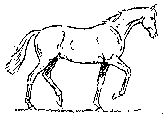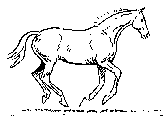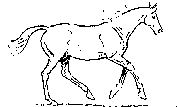|
|
HORSEY TID-BITS
HORSE POWER
What Are Gaits? Here are some terms and their meaning that describe the horses way of moving!! Please refer to the animation for an example!!
WALK --  This is a
four-beat gait in which each hoof beat can be heard separately. The order
goes like this; right hind, then right fore, then left hind, and then
left fore. Basically, each side strikes the ground before the other
side does.
This is a
four-beat gait in which each hoof beat can be heard separately. The order
goes like this; right hind, then right fore, then left hind, and then
left fore. Basically, each side strikes the ground before the other
side does.
TROT --  This gait is also known as the Jog, is an even, two-beat gait. The
left fore leg and right hind leg move together as a pair, as the right hind
leg and left fore leg. There is a small moment of suspension.
The trot is great for covering lots of ground, without tiring the horse
out so easily. There are several variations of the trot; collected trot,
regular trot, and extended trot. No matter what the speed, the legs work
the same way.
This gait is also known as the Jog, is an even, two-beat gait. The
left fore leg and right hind leg move together as a pair, as the right hind
leg and left fore leg. There is a small moment of suspension.
The trot is great for covering lots of ground, without tiring the horse
out so easily. There are several variations of the trot; collected trot,
regular trot, and extended trot. No matter what the speed, the legs work
the same way.
Pace -- This gait is also a two-beat gait, however the legs on the same side of the body, move together as a pair. This makes the horse appear to have a "rolling" action, because he is shifting his weight from side to side. (Sorry no picture)
CANTER --  This
is also called a Lope and is a 3-beat gait, which means that the first
& third beats are made by two legs striking the ground independently and the
2nd beat is made by the two other legs striking the ground at the same
time. There is a moment of suspension when all four feet are off the
ground.
This
is also called a Lope and is a 3-beat gait, which means that the first
& third beats are made by two legs striking the ground independently and the
2nd beat is made by the two other legs striking the ground at the same
time. There is a moment of suspension when all four feet are off the
ground.
GALLOP --  The
Gallop or Run is a 4-beat gait, in which the paired diagonals (left hind &
right fore; right hind and left fore) do not land at the same time. This
gait also has a moment of suspension. This would be considered the fastest
gait for the horse.
The
Gallop or Run is a 4-beat gait, in which the paired diagonals (left hind &
right fore; right hind and left fore) do not land at the same time. This
gait also has a moment of suspension. This would be considered the fastest
gait for the horse.
BACK -- The Back is similar to the way the horse moves at a trot, except the horse is performing it at a walk and in reverse. Every horse should know how to back with a rider, to get out of situations, that may require the horse to back up to get out of.
CLASSIFICATION OF BREEDS ��������
There are several breeds of horses throughout the World; Light Horse Breeds, Registeries with Color Requirements, Draft Horses, Pony Breeds, and Miniature Horses. � I will try to cover each of them, however, since there are so many different breeds of horses, it may be impossible to announce them all.
I will make reference to their size and weight.� Let me explain to you what a hand is.� A hand is the equivalent to 4 inches. To better describe this.� If you were to take your hand and hold your fingers against one another minus the thumb that would equal 4 inches. (approximately).� You measure the horse from the highest point of the withers to the ground near the front leg.� A 15-2 hand horse would be 62 inches tall at the withers.
Light Horse Breeds include the American Quarter Horse which were very popular in the early 1800's.� The breed association for the Quarter Horse was founded in the 1941.� Quarter Horses got their name, because they were known for their quick bursts of speed and their ability to run the fastest in a 1/4 mile. These horses are used for cattle work on and off the farm, showing and recreational purposes.
Arabians are known for their endurance racing and competitive trail rides.� King Solomon is said to have owned Arabians around 1635 B.C.� A registry for Arabians was formed in 1908 and before that The Jockey Club registered purebred Arabians.� These horses are also used for showing and recreational purposes
Thoroughbreds is what dominates most of the racing that you see today on television.� Bets are placed on these horses for money.� These horses were imported to America around the year 1730 from England.� These horses are used for racing, jumping, dressage, racing and also recreational purposes.� There are currently associations that are trying to "re-cycle" Thoroughbreds that no longer have the heart to race, have never one a race, or perhaps might have a recurring injury that may not recur if this horse was turned to a different lifestyle.� These horses mature up to 15.1 to 16.2 hands tall and usually weigh around 900 to 1,200 pounds.
Standardbreds were also imported from England.� Standardbreds can be pacers or trotters.� They make great riding mounts and racing horses. � Standardbreds also have associations that are fighting for them as well, trying to find good homes because of one reason or another, that they are just not able to race anymore.
Morgans were not imported anywhere, but they were founded in the New England States.� They were purposely bred for general purpose work; carrying passengers to and from town, pulling a log,�� Morgans today are used for cattle work, trail riding, jumping and various events.� These horses are typically 14.2 to 15.2 hands tall and weigh 900 to 1,100 pounds.
The American Saddlebred was developed in Kentucky by using Thoroughbred and Morgan bloodlines.� American Saddlebreds are currently shown in three-gaited (walk, trot, canter) or five-gaited classes (walk, trot, slow gait, rack & canter). � Their body characteristics are normally very animated, such as upright head and neck, and very flashy leg movements.
The Tennessee Walking Horse originated of course in Tennessee bluegrass region.� This horse produces a smooth, gliding motion that is comfortable to ride.� It is almost like you aren't even moving.
Horses that have color requirements include the American Buckskin. � This horse is predominately a yellow shade, but not red, and black mane & tail. � They may or may not have a dorsal stripe (black) running down their backbone.
The Palomino is typically of a golden yellow color, with variations. They must have a full white mane and natural white tail.
Paint or Pinto horses usually have body markings of white and another color.� Some of the patterns on these horses are very striking and makes this horse "flashy" to the human eye.� There are a lot of horse owners that like "flashy" patterns, because it may catch the judges' eye in the show ring.
The Appaloosa dates back to drawings made by early humans on the cave walls in France.� The Nez Perce` had many Appaloosas and in 1877 this breed nearly disappeared.� This breed of horse is also very colorful and "flashy".
The heavyweights are called draft horses.� The Percheron originated in France and back in the 17th & 18th century these horses were not very tall. � They were only approximately 15 to 16 hands and were use for general use. � However, since then, these horses are used to pull heavy farm equipment or bred with Thoroughbreds to produce a nice hunter/jumper for showing.
The horses that pull the Budweiser wagon are Clydesdales.� These horses are known for "feathers" on their legs which makes them very "flashy". � These horses were founded in Southern Scotland around the late 1700's to early 1800's.� They were first imported to Canada in 1842 and then to the United States in 1870.� These horses weigh approximately 1,700 to 2,000 pounds and that figure depends on age and sex of the horse.
Belgian horses originate from Belgium and played a big part of the Roman cavalry.� They were first introduced into America in the 1880's.� They weigh about 2,000 pounds and are 16.2 to 17 hands tall.
Shires are a very big and magnificent horse that typically weighs approximately 2,000 pounds and stand 16.2 to 17 hands tall.� These horses are well known for their appearance and temperament; "feathers" on their legs and a sluggish temperament.� They were introduced to the states in 1853 as a draft horse for farming from Holland.� They were not a popular breed because of their appearance and temperament.�
Some of the pony breeds are Welsh or Welsh Mountain pony, Connemara, Pony of the Americas, and the Shetland. All these ponies stand anywhere from 10 to 14 hands.� Ponies can be stubborn, but they make great partners for children to learn their horsemanship skills on.� Some of them make great jumpers like the Connemara.�
And last but not least, the Miniature Horse is making such a comeback. � These horses are very rare and were first bred in Argentina in 1868.� The smallest miniature horse has been 15 inches tall and the maximum height is 32 inches. � So if you were to place a miniature horse next to a draft horse, there would be a very noticeable difference.
I would like to reference the following book for its assistance in providing this information to you.
����� � Horses; A Guide to Selection, Care, and Enjoyment by J. Warren Evans, 1981.�
�
�
�
�
�
���
�
�